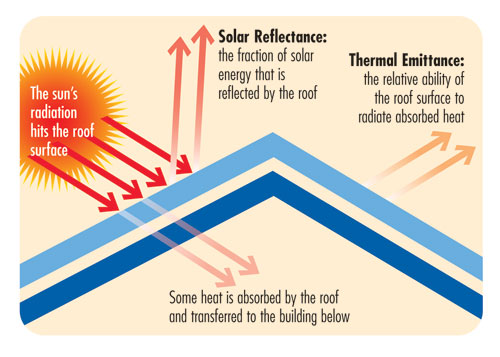As green building strategies evolve to keep up with increasingly stringent building energy codes and standards, so do cool roofs. A roof, as any other building component, can be selected to best serve a particular purpose, such as weather resistance or thermal regulation. Cool roofs are optimally designed to minimize the transfer of heat from the sun to the interior of a building.
A cool roof is defined by the radiative properties of the roof’s outer layer, or more specifically, by its solar reflectance and thermal emittance properties. Solar reflectance is a measure of the portion of initial solar radiation that is immediately reflected off the roof surface back in the atmosphere without heating the roof itself. Thermal emittance is a measure of the solar energy that the roof re-emits, or re-releases into the atmosphere as infrared light, after being initially absorbed. The remainder of the solar energy, that which is neither reflected nor re-emitted, is transferred to the building as heat or is convected by ambient breezes into the surrounding atmosphere, heating the surrounding air. The amount of solar energy transferred to a building can therefore be influenced by the roof design and construction (See below).

Thanks to advances in materials technology, white roofs are no longer the only type of cool roof available. Cool color pigments have been developed to efficiently reflect solar energy (light) in the Near Infrared (NIR) spectrum, whereas standard colors tend to absorb NIR energy. The NIR spectrum is invisible to the human eye, so two seemingly identical colors in the visible spectrum can perform differently in the NIR spectrum. With vast color and material choices, selecting an aesthetically pleasing roof design while maintaining cool roof performance is now possible.
In addition to reduced building energy consumption from diminished air conditioning requirements, cool roofs have numerous indirect benefits, including cutting greenhouse gas emissions, alleviating the urban heat island effect, reducing smog, as well as various public health benefits.
Cool roofs reduce greenhouse gas emissions by conserving electricity and reducing power plant production demand incurred from air conditioning use. Creating electricity not only wastes a great deal of energy in the conversion process, but also produces CO2, particulate matter and other air pollutants.
Cities can be 2 degrees to 8 degrees warmer than surrounding environments due to the large areas of dark surfaces, consisting mainly of roads, parking lots and dark-colored roofs. The extra heat absorbed through dark surfaces during the day is convected away by ambient breezes, raising air temperature averages; this phenomenon is referred to as the urban heat island effect. Cool roofs help mitigate the intensity of the urban heat island effect by reducing heat absorption and transfer to the surrounding air.
Lower ambient air temperatures resulting from cool roof applications also reduce the production of smog, a process accelerated by warmer temperatures. Reduced greenhouse gas emissions and smog production benefit public health by reducing the prevalence of asthma and other respiratory health conditions aggravated by air pollution.
As building technologies improve, building codes and programs have evolved to enforce strategic green building design and construction practices. The following section provides an overview of some cool roofing codes, green building programs, rebate programs and tax credits. For more information, please visit www.coolroofs.org.
Two primary organizations, the International Code Council (ICC) and the American Society of Heating and Air- Conditioning Engineers (ASHRAE), have developed National Model Energy Codes. These codes are not mandatory or enforceable until a jurisdiction adopts the documents as part of regulation or law. In the United States, many states and jurisdictions have adopted these codes, while others like California have developed their own.
Rebate Programs: As the green building movement sweeps the country, more utilities across the United States are providing incentives for cool roofs. States with current utility rebate programs include Arizona, California, North Carolina, South Carolina, Georgia, Colorado, Florida, Idaho, New Jersey, New York and Texas.
Cool roof purchases before December 31, 2010 qualify for a $1,500 dollar tax credit. For more information please visit our website.

It's nice to find a site you can trust.Visit coolearthcontracting.com this site was recommended by a friend so I tried it.They provide a Cool Roofs, Reflective roof, Reflective Paint Austin and Commercial roof at affordable price.Their service was great.
ReplyDeleteYou post the nice information about Energy Roofing Systems.It is beneficial for us.Thanks for sharing this information.
ReplyDeletelow slope roofing systems